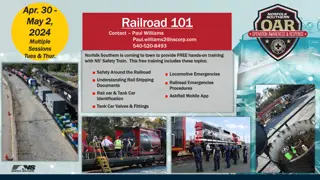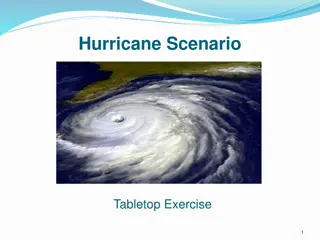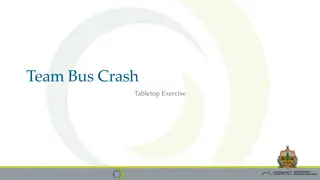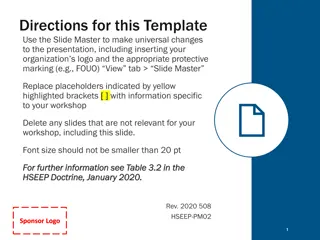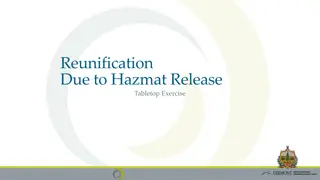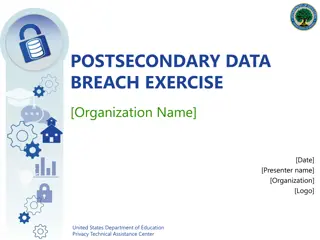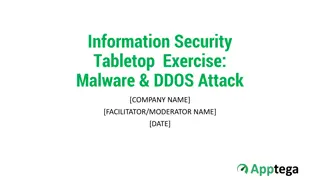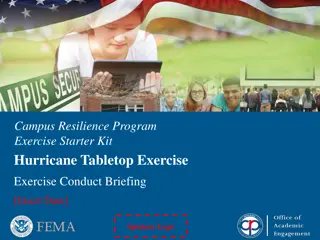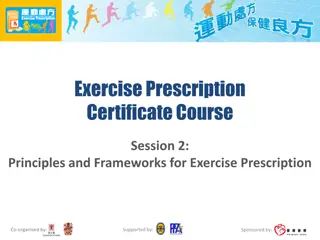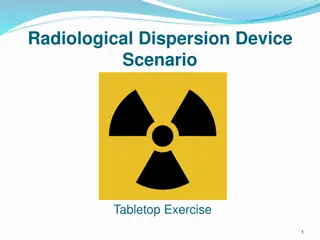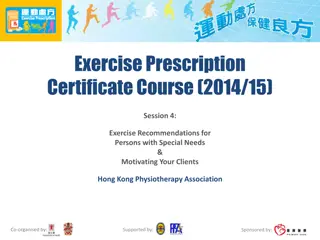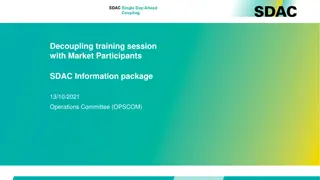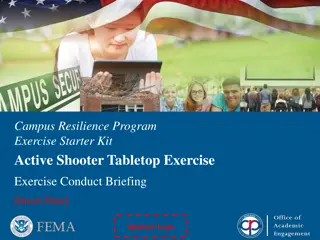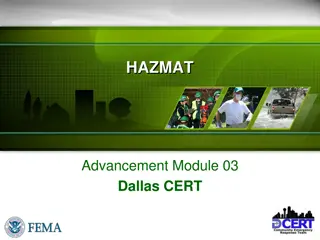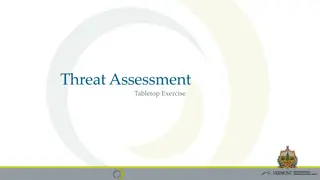Operational Coordination and Communications HAZMAT Scenario Exercise Conduct Brief
The document serves as the Hazardous Material Spill/Contamination Facility or Train Derailment Scenario Conduct Slide Deck for the Operational Coordination and Communications Principals Strategic Priority. It includes guidelines for tailoring the exercise to an organization's needs, conducting the scenario, and facilitating discussions on response and recovery efforts in such scenarios.
Download Presentation

Please find below an Image/Link to download the presentation.
The content on the website is provided AS IS for your information and personal use only. It may not be sold, licensed, or shared on other websites without obtaining consent from the author. Download presentation by click this link. If you encounter any issues during the download, it is possible that the publisher has removed the file from their server.
E N D
Presentation Transcript
Operational Coordination and Communications HAZMAT Spill/Contamination Facility or Train Derailment Scenario Exercise Conduct Brief [Month, Date, Year] Sponsor Logo Sponsor Logo Ver. 1
READ FIRST This document serves as theHazardous Material Spill/Contamination Facility or Train Derailment Scenario Conduct Slide Deck for the Operational Coordination and Communications Principals Strategic Priority Please select the scenario that best fits your jurisdiction s/organization s needs In order to tailor this conduct deck to your organization, first replace the placeholder Sponsor Logo graphic on slide one with your organization s logo To tailor the content in this conduct deck to the desired goals and outcomes for this exercise, please read through the entire deck and fill in all bracketed content that is highlighted in red This document is to be used in tandem with the Hazardous Material Spill/Contamination Facility or Train Derailment Scenario Facilitator Guide and Situation Manual so any changes made to this deck will need to be carried over into those documents **Delete slide upon completion**
Welcome and Introductions [Name] [Title] [Department/Agency/Organization] [Name] [Title] [Department/Agency/Organization] Sponsor Logo 3
Read First The Exercise Schedule slide and Exercise Overview section are written to include two pre-populated scenario modules Revise the Exercise Schedule slide and Exercise Overview section as necessary if choosing to exercise one or both of the provided modules **Delete slide upon completion**
Exercise Schedule Welcome and Introductions Exercise Overview Module 1: Response Break Module2:Recovery Break Hotwash Closing Remarks [Time] [Time] [Time] [Time] [Time] [Time] [Time] [Time] Sponsor Logo 5
Exercise Overview Sponsor Logo 6 6
Overview Exercise Purpose: The purpose of this exercise is to examine critical issues and capabilities related to response and recovery from a Hazardous Material (HAZMAT) Spill/Contamination from a Facility or Train Derailment incident Exercise Scope: This [insert number]-hour tabletop exercise (TTX) will be divided into two Modules: Module 1: Response Module 2: Recovery Mission Areas: Response & Recovery Sponsor Logo 7
READ FIRST The exercise objectives contained in the following slide(s) are provided as sample objectives These can be tailored as appropriate to align with the overarching goals and desired outcomes for the exercise Please note that changes made to the objectives will need to be reflected in the following: Hotwash section of this Conduct Slide Deck Associated Facilitator Guide for this scenario Associated Situation Manual for this scenario **Delete slide upon completion**
Exercise Objectives/Core Capabilities 1. Discuss how to establish an effective command structure that integrates all critical stakeholders to ensure community resources are used efficiently - Aligned Core Capabilities: Operational Coordination 2. Review the ability to provide and/or support the delivery of consistent communications throughout an incident with all stakeholders - Aligned Core Capabilities: Operational Communications Sponsor Logo 9
Exercise Objectives/Core Capabilities 3. Examine the capacity for timely sharing of information in support of security, situational awareness, and operations to include effective alert and notification processes for affected communities and response forces Aligned Core Capabilities: Situational Awareness and Public Information and Warning 4. Discuss the ability to effectively provide and manage medical treatment via emergency medical services, hospital care, and related operations Aligned Core Capabilities: Public Health, Healthcare, and Emergency Medical Services Sponsor Logo 10
Exercise Participants [Insert Participating Organization] [Insert Participating Sub-Organization] [Insert Participating Organization] [Insert Participating Sub-Organization] [Insert Participating Organization] [Insert Participating Sub-Organization] Sponsor Logo 11 11
Exercise Guidelines This is an open no-fault environment - varying viewpoints, even disagreements, are expected Base your responses on existing plans, policies, procedures, capabilities, and resources Please assume the exercise scenario is plausible, and events occur as they are presented Decisions are notprecedent setting; consider different approaches and suggest improvements There is no hidden agenda nor are there any trick questions [Insert additional guidelines as appropriate] Sponsor Logo 12
Module Overview Each Module will consist of two activities: Scenario Overview: Each Module will contain a detailed overview of the scenario including a video update of the current situation (if applicable) 1. Facilitated Discussions: Participants will engage in facilitated discussions surrounding a set of discussion questions Questions in each Module aim to capture critical issues related to exercise objectives in each mission area 2. Sponsor Logo 13
Start of Exercise Sponsor Logo 14 14
Read First Please ensure that you select one scenario that fits the needs of your jurisdiction/organization Exercise planners can choose to exercise one or both of the Modules in sequence depending on the needs of your jurisdiction or organization If necessary, remove or change the Module slides that your jurisdiction or organization is not exercising **Delete slide upon completion**
Module 1: Initial Response Sponsor Logo 16 16
Module 1: Scenario 1 Overview Initial Response Facility First aid stations near a crowded [insert venue] during [insert event] begin receiving several individuals with eye pain and burning noses, uncontrollable coughing, and difficulty breathing 9-1-1 is inundated with similar calls from victims in the surrounding area, along with reports of a strong swimming pool smell The number of patients steadily increases at the first aid stations and they request emergency medical care along with transport to local hospitals Patient symptoms are reported to local medical facilities and police and fire departments are alerted to the unfolding public health incident The situation at [insert venue] and surrounding area is growing chaotic Sponsor Logo 18
Module 1: Scenario 1 Overview (cont.) Initial Response Facility Local news and media covering the [insert event] describe the scene unfolding as people begin retreating from the event Medical facilities in the area report a surge of patients in respiratory distress People begin to self-evacuate to first aid stations and offer unrequested assistance to EMS personnel The local fire department deploys a HAZMAT team that identifies a chemical cloud originating from a nearby facility housing industrial chemicals After setting up decontamination and support areas, the HAZMAT team enters the facility and discovers a chlorine leak emanating from a catastrophic rupture in a large pressurized tank Sponsor Logo 19
Module 1: Scenario 2 Overview Initial Response Train Derailment It is the morning of [insert day], [insert date], in [insert location]. The temperature is [insert degrees] with a [insert wind speed] winds out of the [insert direction]. A 9-1-1 call comes in to the local police department from a nearby facility that is close to the railroad tracks reporting a bleach gas smell and a yellow-green smoke on the ground from what is described as a train derailment The local fire department responds and find that two trains collided with a total of 30 rail tank cars that have DOT markings (111 & 105) on them The deployed HAZMAT team identifies the chemical originating from the yellow-green smoke on the ground as chlorine Sponsor Logo 20
Module 1: Scenario 2 Overview (cont.) Initial Response Train Derailment There are two crewmembers injured, with one having a head injury and the other (conductor) sustaining a leg injury. The chlorine cloud has now engulfed the engine compartment and the area around Additional 9-1-1 calls start coming in from nearby homes and facilities reporting the same bleach gas smell and people complaining of having trouble breathing People begin to self-evacuate to the emergency room and medical facilities in the area report a surge of patients in respiratory distress Local news and media covering the incident describe the scene unfolding as the chlorine cloud continues to grow and moves [insert direction] Sponsor Logo 21
Module 1: Discussion Questions (1/4) Operational Coordination 1. Based on the current scenario, which agency will assume incident command? What are your initial priorities and incident objectives at this point? Who determines resource requirements? 2. What interagency coordination is necessary at this stage of the incident? 3. How does your organization identify and establish community structures and priorities during the initial response phase of an incident? Who are your key local and private sector stakeholders, and how do you coordinate with them? 4. [Insert additional discussion questions] Sponsor Logo 22
Module 1: Discussion Questions (2/4) Operational Communications 1. How do you communicate with critical partners and stakeholders to maintain situational awareness? Who are those stakeholders at this point in the incident? 2. How does your organization collaborate with stakeholders to develop, coordinate, and disseminate information and notifications to the public? Who would be responsible for releasing these messages? What would be the topic of these messages? Who are the target audiences? 3. [Insert additional discussion questions] Sponsor Logo 23
Module 1: Discussion Questions (3/4) Situational Assessment & Public Information and Warning 1. Describe the alert and notification processes for this type of incident 2. How is information that is provided to local partners and the public coordinated across local, state, and federal agencies, as well as the private sector? What information-sharing mechanisms are used to provide information to the public? 3. Who is responsible for talking to the media? 4. Identify the greatest public communications challenges facing your community within the first few hours of the incident 5. [Insert additional discussion questions] Sponsor Logo 24
Module 1: Discussion Questions (4/4) Public Health, Healthcare, and Emergency Medical Services 1. What are the current medical priorities? Who is responsible for making this determination? 2. How do first responders in your community coordinate with medical facilities? 3. Are existing medical facilities equipped to effectively handle the number of patients as well as the treatment necessary for patients with chemical poisoning? 4. What plans, policies, and procedures exist to address self- deploying medical personnel? The worried well? 5. [Insert additional discussion questions] Sponsor Logo 25
Break Sponsor Logo 26 26
Module 2: Initial Recovery Sponsor Logo 27 27
Module 2: Scenario 1 Overview Initial Recovery - Facility Hospitals are inundated with patients and medical personnel and resources quickly become strained The [insert your jurisdiction s public official- e.g., Mayor] requests information to report to the public, including how the chlorine leak occurred and when it will be contained [Insert your jurisdiction s public official- e.g., Mayor] also requests information on what protective measures to take, how long before it is safe to return to the area, and numbers of sick individuals HAZMAT specialists estimate that it may take several hours before there is adequate improvement to air quality Sponsor Logo 29
Module 2: Scenario 1 Overview (cont.) Initial Recovery - Facility Public officials, media crews, and volunteers arrive near [insert venue] to locate their loved ones and begin demanding answers Social media posts emerge highlighting the situation; much of that information is false and is inciting additional public panic Experts confirm that the ruptured tank contained 90 tons of chlorine Due to the magnitude of the leak, there is some concern that chlorine may have contaminated ground water, which could have long-term health effects Staff from the chemical facility have arrived on scene as well as representatives from the local environmental department Sponsor Logo 30
Module 2: Scenario 2 Overview Initial Recovery Train Derailment Hospitals are inundated with patients and medical personnel and resources quickly become strained The [insert your jurisdiction s public official- e.g., Mayor] requests information to report to the public, including how the chlorine leak occurred and when it will be contained [Insert your jurisdiction s public official- e.g., Mayor] also requests information on what protective measures to take, how long before it is safe for residents to return home and businesses to re-open, and numbers of sick individuals HAZMAT specialists estimate that it may take several hours before there is adequate improvement to air quality Sponsor Logo 31
Module 2: Scenario 2 Overview (cont.) Initial Recovery Train Derailment The morning commute is starting to become severely impacted due to road closures and additional traffic as residents and businesses evacuate the area Social media posts emerge highlighting the situation; much of that information is false and is inciting additional public panic A volunteer temporary shelter has opened and residents are beginning to show up for assistance Due to the magnitude of the leak, there is some concern that chlorine may have contaminated ground water, which could have long-term health effects Representatives from the railroad company and National Transportation Safety Board have arrived on scene as well as representatives from the local environmental department Sponsor Logo 32
Module 2: Discussion Questions (1/4) Operational Coordination 1. What are your resource requirements and needs during this stage of the incident? Who coordinates requests for external assets? Will mutual aid need to be requested at this time? If so, how long will it take for mutual aid resources to arrive? 2. What stakeholders would be engaged during this phase of the incident? What are their roles and responsibilities? 3. What are your procedures for determining and executing coordination requirements among all critical stakeholders? 4. [Insert additional discussion questions] Sponsor Logo 33
Module 2: Discussion Questions (2/4) Operational Communications 1. How does your organization maintain communication and information flow within a unified operational structure? 2. Do all relevant agencies and jurisdictions have interoperable communication capabilities? How do you maintain consistent communication with stakeholders throughout an incident? How do you define and communicate clear roles and responsibilities? 3. [Insert additional discussion questions] Sponsor Logo 34
Module 2: Discussion Questions (3/4) Situational Assessment & Public Information and Warning 1. How are changes to the situation communicated to all stakeholders? 2. What is the content of the information/messaging during the later stages of an incident? - For traditional platforms? - For social media? 3. Are there pre-scripted media messages for this type of incident? 4. What is the greatest public communications challenge created by this type of incident? 5. [Insert additional discussion questions] Sponsor Logo 35
Module 2: Discussion Questions (4/4) Public Health, Healthcare, and Emergency Medical Services 1. Based on the information provided, what are the top priorities during this stage of the incident for local medical facilities? For emergency medical personnel? 2. Do EMS personnel and/or medical facilities have adequate assets for sustained operations following this incident? If not, what plans or procedures would need to be activated to support these efforts? 3. What are the potential health concerns at this time? What plans, policies, or procedures exist to address these concerns? 4. [Insert additional discussion questions] Sponsor Logo 36
End of Exercise Sponsor Logo 37 37
Break Sponsor Logo 38 38
Hotwash Sponsor Logo 39 39
Hotwash Overview The hotwash aims to capture the following information for each of the exercise objectives: 1. Strengths observed throughout the exercise (e.g., what worked well) 2. Challenges and/or areas for improvement observed throughout the exercise 3. Major takeaways and key action items to include who is responsible for those action items Sponsor Logo 40
READ FIRST Please ensure that the exercise objectives in the following slides reflect any changes made to the objectives contained in previous sections of this Conduct Slide Deck **Delete slide upon completion**
Exercise Objective #1 Operational Coordination: Discuss how to establish an effective command structure that integrates all critical stakeholders to ensure community resources are used efficiently Observed strengths Observed challenges and/or areas for improvement Takeaways and/or action items, including the responsible parties Sponsor Logo 42
Exercise Objective #2 Operational Communications: Review the ability to provide and/or support the delivery of consistent communications throughout an incident with all stakeholders Observed strengths Observed challenges and/or areas for improvement Takeaways and/or action items, including the responsible parties Sponsor Logo 43
Exercise Objective #3 Situational Assessment & Public Information and Warning: Examine the capacity for timely sharing of information in support of security, situational awareness, and operations to include effective alert and notification processes for affected communities and response forces Observed strengths Observed challenges and/or areas for improvement Takeaways and/or action items, including the responsible parties Sponsor Logo 44
Exercise Objective #4 Public Health, Healthcare, and Emergency Medical Services: Discuss the ability to effectively provide and manage medical treatment via emergency medical services, hospital care, and related operations Observed strengths Observed challenges and/or areas for improvement Takeaways and/or action items, including the responsible parties Sponsor Logo 45
Closing Remarks [Name] [Title] [Department/Agency/Organization] Sponsor Logo 46
A Letter from the Director I would like to thank each individual for taking the time out of your busy schedule to participate in the exercise and extend a special thank you to the Exercise Sponsors and Exercise Planning Team for utilizing the National Exercise Program s Exercise Starter Kit (ESK). Your participation clearly demonstrates your understanding of the vital role that exercises play in the supporting the National Preparedness Goal of A secure and resilient Nation NEP evaluation is focused on using the results of exercises, documented in AARs, to validate capability levels, identify lessons learned, and develop corrective actions, while also ensuring the entire Nation benefits from the knowledge and experience gained through these exercises. I am asking each Exercise Sponsors to submit their After-Action Report/Improvement Plan or Exercise Results via the Submit Your Feedback button on the applicable ESK. In order to protect this information and to foster an environment in which preparedness stakeholder can provide honest assessments, FEMA assures the that assessments will not be distributed by FEMA outside of the Federal Government unless otherwise required by law. This data will not to be used to grade, rate, rank, or formally evaluate any stakeholder, nor is this data to be publicly released in any format in which it can be attributed to any specific stakeholder. I would also appreciate any feedback concerning the use of this ESK. Please submit feedback via the Submit Your Feedback button found on the applicable ESK page. Thank you, Chad Gorman Chad Gorman, Director National Exercise Division






